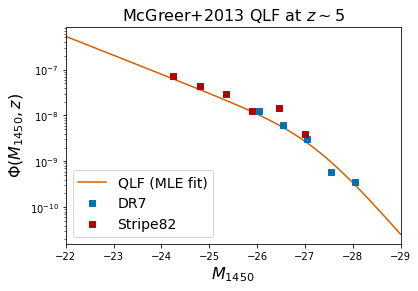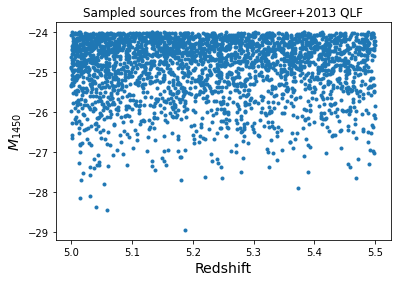atelier.lumfun - Introduction
Introduction to the Atelier’s luminosity function classwith a strong emphasis on quasar luminosity functions
[1]:
# General imports
import numpy as np
import matplotlib.pyplot as plt
from astropy.cosmology import FlatLambdaCDM
# Importing the luminosity function module
from atelier import lumfun
1) Introduction to the luminosity function object
1.1) Instantiating the luminosity function object
ADS reference: https://ui.adsabs.harvard.edu/abs/2013ApJ…768..105M/abstract The quasar luminosity function in the paper is defined using a broken double power law with the luminosity in magnitudes. An implementation of a magnitude based broken double power law luminosity function already exists in the lumfun module.
[2]:
print(lumfun.DoublePowerLawLF.__doc__)
Luminosity function, which takes the functional form of a double
power law with the luminosity in absolute magnitudes.
The luminosity function has four main parameters:
- "phi_star": the overall normalization
- "lum_star": the break luminosity/magnitude where the power law slopes
change.
- "alpha": the first power law slope
- "beta": the second power law slope
The four main parameters need to be specified either as parameters or as functions. In this example only the source density normalization is a function, which depends on redshift (redsh), a z=6 normalized value of the source density log_phi_star and a parameter k.
[3]:
# Define the source density normalization as in McGreer+2013
def phi_star(redsh, log_phi_star, k):
return 10 ** (log_phi_star + k * (redsh - 6))
log_phi_star = lumfun.Parameter(-8.94, 'log_phi_star', one_sigma_unc = [0.24, 0.20])
k = lumfun.Parameter(-0.47, 'k', vary=False)
We begin with defining the function for phi_star and its parameters. Redshift (redsh) and luminosity (lum) are always arguments of the luminosity function and do not require further definition. However, we need to define and provide log_phi_star and k.
For these parameters we use the lumfun.Parameter class which has the following attributes:
[4]:
print(lumfun.Parameter.__doc__)
A class providing a data container for a parameter used in the
luminosity function class.
Attributes
----------
value : float
Value of the parameter
name : string
Name of the parameter
bounds : tupler
Bounds of the parameter, used in fitting
vary : bool
Boolean to indicate whether this parameter should be varied, used in
fitting
one_sigma_unc: list (2 elements)
1 sigma uncertainty of the parameter.
In the next step we define the other three main parameters and instantiate the broken double power law luminosity function (atelier.lumfun.DoublePowerLawLF).
[5]:
lum_star = lumfun.Parameter(-27.21, 'lum_star', one_sigma_unc = [0.33, 0.27])
alpha = lumfun.Parameter(-2.03, 'alpha', vary=True, one_sigma_unc = [0.14, 0.15])
# The beta slope does not have an uncertainty as it set to -4 in McGreer+2013
beta = lumfun.Parameter(-4, 'beta', bounds=[-8, -3])
# Wrapping the parameters in a dictionary
parameters = {'log_phi_star': log_phi_star, 'k': k, 'lum_star': lum_star,
'beta': beta, 'alpha': alpha}
# Wrapping the parameter functions (param_functions) in a dictionary
param_functions = {'phi_star': phi_star}
# The luminosity function type attribute is used in specific calculations based on the luminosity function
# only lum_type = 'M1450' has a special meaning at the moment.
lum_type = 'M1450'
mcgreer2013 = lumfun.DoublePowerLawLF(parameters, param_functions, lum_type=lum_type)
[INFO]---------------------------------------------------
[INFO] Performing initialization checks
[INFO]---------------------------------------------------
[INFO]---------------------------------------------------
[INFO] Main parameter phi_star is described by a function.
[INFO] The function parameters are: ['redsh', 'log_phi_star', 'k']
[INFO] All parameters are supplied.
[INFO] Parameters "lum" and "redsh" were ignored as they are luminosity function arguments.
[INFO]---------------------------------------------------
[INFO] Main parameter lum_star is supplied as a normal parameter.
[INFO]---------------------------------------------------
[INFO] Main parameter alpha is supplied as a normal parameter.
[INFO]---------------------------------------------------
[INFO] Main parameter beta is supplied as a normal parameter.
[INFO]---------------------------------------------------
[INFO] Initialization check passed.
[INFO]---------------------------------------------------
Important With the instantiation of the luminosity function object a verbose check is carried out in which the code automatically checks if all main parameters have been either defined as parameters or as a function of parameters.
1.2) Basic calculations
1.2.1) Calculating the luminosity function
To retrieve values of the luminosity function one can either directly call it supplying a luminosity and redshift (e.g., mcgreer2013(M1450,redsh)) or use the .evaluate(lum,redsh) function. In both cases either the luminosity or the redshift can also be specified as a numpy.ndarray instead of a single float value.
[6]:
# Defining a magnitude array
M1450 = np.arange(-29, -22, 0.01)
# Defining a redshift array
z= np.arange(4, 6, 0.1)
# Calling the luminosity function with a luminosity and a redshift value produces one output value
print(mcgreer2013(-27, 4.9))
# Calling the luminosity function with a np.ndarray in luminosity and a redshift value produces a np.ndarray
print(mcgreer2013(M1450, 4.9).shape)
# Calling the luminosity function with a np.ndarray in redshift and a magnitude value produces a np.ndarray
print(mcgreer2013(-27, z).shape)
2.7377613276931382e-09
(700,)
(20,)
Let us now display the McGreer+2013 quasar luminosity function in comparison to the binned values from the paper, basically reproducing Fig.16 of the publication.
[7]:
# Binned QLF data from the publication
dr7 = {'M1450':np.array([-28.05, -27.55, -27.05, -26.55, -26.05]),
'logPhi':np.array([-9.45, -9.24, -8.51, -8.20, -7.9]),
'simga_logPhi':np.array([0.21, 0.26, 0.58, 0.91, 1.89])*1e-9}
str82 = {'M1450':np.array([-27.0, -26.45, -25.9, -25.35, -24.8, -24.25]),
'logPhi':np.array([-8.4, -7.84, -7.9, -7.53, -7.36, -7.14]),
'simga_logPhi':np.array([2.81, 6.97, 5.92, 10.23, 11.51, 19.9])*1e-9}
# Color definition for plotting
vermillion = (213/255., 94/255., 0)
dblue = (0, 114/255., 178/255.)
dred = (179/255., 0, 0)
qlf = mcgreer2013(M1450, 4.9)
plt.plot(M1450, qlf, lw=1.5, color=vermillion, label='QLF (MLE fit)')
plt.plot(dr7['M1450'], 10**dr7['logPhi'], 's', color=dblue, label='DR7')
plt.plot(str82['M1450'], 10**str82['logPhi'], 's', color=dred, label='Stripe82')
plt.xlim(-22, -29)
# Make the plot nice
plt.semilogy()
plt.ylabel('$\Phi(M_{1450},z)$', fontsize=16)
plt.xlabel('$M_{1450}$', fontsize=16)
plt.title('McGreer+2013 QLF at $z\sim5$', fontsize=16)
plt.legend(loc=3, fontsize=14)
plt.show()

1.2.2) Calculating the number of quasars in a redshift and luminosity range (per steradian)
The built-in class function .integrate_over_lum_redsh performs the double integral of the quasar luminosity function using the provided input parameters. For this calculation we need to specify a cosmology as the differential comoving solid volume element, which can be provided directly, depends on it.
[8]:
print(mcgreer2013.integrate_over_lum_redsh.__doc__)
Calculate the number of sources described by the luminosity function
over a luminosity and redshift interval in units of per steradian.
Either a cosmology or dVdzdO have to be supplied.
:param lum_range: Luminosity range
:type lum_range: tuple
:param redsh_range: Redshift range
:type redsh_range: tuple
:param dVdzdO: Differential comoving solid volume element (default =
None)
:type dVdzdO: function
:param selfun: Selection function (default = None)
:type selfun: atelier.selfun.QsoSelectionFunction
:param cosmology: Cosmology (default = None)
:type cosmology: astropy.cosmology.Cosmology
:param kwargs:
:return: :math:`N = \int\int\Phi(L,z) (dV/(dz d\Omega)) dL dz`
:rtype: float
[11]:
cosmology = FlatLambdaCDM(H0=70, Om0=0.272)
n_qso_per_steradian = mcgreer2013.integrate_over_lum_redsh([-29,-24],[5,5.5], cosmology=cosmology)
print('There are {:.5f} quasars per steradian within z=5-5.5 and with M1450=-29 to -24 (using romberg integration)'.format(n_qso_per_steradian))
n_qso_per_steradian = mcgreer2013.integrate_over_lum_redsh_simpson([-29,-24],[5,5.5], cosmology=cosmology)
print('There are {:.5f} quasars per steradian within z=5-5.5 and with M1450=-29 to -24 (using Simpsons rule on a grid)'.format(n_qso_per_steradian))
There are 936.08722 quasars per steradian within z=5-5.5 and with M1450=-29 to -24 (using romberg integration)
There are 936.08637 quasars per steradian within z=5-5.5 and with M1450=-29 to -24 (using Simpsons rule on a grid)
1.2.3) Calculating the quasar number density over a luminosity range (per Mpc^3)
The built-in class function .integrate_lum performs this integral using the provided input parameters.
[10]:
print(mcgreer2013.integrate_lum.__doc__)
Calculate the volumetric source density described by the luminosity
function at a given redshift and over a luminosity interval in units of
per Mpc^3.
:param redsh: Redshift
:type redsh: float
:param lum_range: Luminosity range
:type lum_range: tuple
:param kwargs:
:return: :math:`\int \Phi(L,z) dL`
:rtype: float
[11]:
n_qso_per_Mpc3 = mcgreer2013.integrate_lum(4.9,[-29,-24])
print('The quasar density (in Mpc^-3) over M1450=-29 to -24 is {:.2e} at redshift z=4.9'.format(n_qso_per_Mpc3))
The quasar density (in Mpc^-3) over M1450=-29 to -24 is 8.53e-08 at redshift z=4.9
1.2.4) Calculating the quasar number density over a luminosity range (per steradian)
The built-in class function .redshift_density performs this integral using the provided input parameters. This quantity is rarely used in normal calculations based on the quasar luminosity function.
[12]:
print(mcgreer2013.redshift_density.__doc__)
Calculate the volumetric source density described by the luminosity
function at a given redshift and over a luminosity interval in units of
per steradian per redshift.
:param redsh: Redshift
:type redsh: float
:param lum_range: Luminosity range
:type lum_range: tuple
:param dVdzdO: Differential comoving solid volume element (default =
None)
:type dVdzdO: function
:param kwargs:
:return: :math:`\int \Phi(L,z) (dV/dz){d\Omega} dL`
:rtype: float
[13]:
dVdzdO = lumfun.interp_dVdzdO([4.0,6.0], cosmology)
n_qso_per_steradian_per_z = mcgreer2013.redshift_density(4.9,[-29,-24],dVdzdO)
print('The quasar density (per steradian and per redshift(!)) over M1450=-29 to -24 is {:.2e} at redshift z=4.9'.format(n_qso_per_steradian_per_z))
The quasar density (per steradian and per redshift(!)) over M1450=-29 to -24 is 2.80e+03 at redshift z=4.9
1.3) Calculating the ionizing emissivity at 1450A (or 912A)
Another built-in class function, which is only defined for broken double power laws and single power laws (both based on magnitude) and for quasar luminosity functions with lum_type = ‘M1450’ is .calc_ionizing_emissivity_at_1450A. To properly test this function and compare it with published results on the ionizing emissivity we use the pre-defined quasar luminosity function (single power law parametrization) of Wang+2019.
ADS reference: https://ui.adsabs.harvard.edu/abs/2019ApJ…884…30W/abstract
[14]:
wang2019spl = lumfun.WangFeige2019SPLQLF()
[INFO]---------------------------------------------------
[INFO] Performing initialization checks
[INFO]---------------------------------------------------
[INFO]---------------------------------------------------
[INFO] Main parameter phi_star is supplied as a normal parameter.
[INFO]---------------------------------------------------
[INFO] Main parameter alpha is supplied as a normal parameter.
[INFO]---------------------------------------------------
[INFO] Main parameter lum_ref is supplied as a normal parameter.
[INFO]---------------------------------------------------
[INFO] Initialization check passed.
[INFO]---------------------------------------------------
We use the same integration boundaries (M1450=-30 to -28) at a redshift of z=6.7
[15]:
e1450 = wang2019spl.calc_ionizing_emissivity_at_1450A(6.7, [-30,-18])
# Adopting a power law slope of -0.6 we scale the ionizing emissivity at 1450A to 912A (Lyman break)
e912 = e1450*(1450./912)**-0.6
print('Calculated ionizing emissivity at 1450A e1450={:.2e}'.format(e1450))
print('Rescaled ionizing emissivity to 912A e912={:.2e}'.format(e912))
print('Ionizing emissivity at 912A calculated in Wang2019 for the single power law QLF e912=2.10e+23')
Calculated ionizing emissivity at 1450A e1450=2.77e+23
Rescaled ionizing emissivity to 912A e912=2.10e+23
Ionizing emissivity at 912A calculated in Wang2019 for the single power law QLF e912=2.10e+23
2) Sampling from the luminosity function
A built-in class function allows to sample sources from a luminosity function. The sampling is done in a two step process. 1) The redshift range is divided into small bins and the number of expected sources per bin is calculated. 2) A cumulative distribution of the quasar luminosity function is calculated at the redshift bin middle and the number of expected sources for the redshift bin is taken. Sources for all bins are concatenated and returned.
Note! This sampling routine is in large part inspired by https://github.com/imcgreer/simqso/blob/master/simqso/lumfun.py , lines 219 and following.
[16]:
print(mcgreer2013.sample.__doc__)
Sample the luminosity function over a given luminosity and
redshift range.
This sampling routine is in large part adopten from
https://github.com/imcgreer/simqso/blob/master/simqso/lumfun.py
, lines 219 and following.
If the integral over the luminosity function does not have an
analytical implementation, integrals are calculated using
integrate.romberg, which can take a substantial amount of time.
:param lum_range: Luminosity range
:type lum_range: tuple
:param redsh_range: Redshift range
:type redsh_range: tuple
:param cosmology: Cosmology (default = None)
:type cosmology: astropy.cosmology.Cosmology
:param sky_area: Area of the sky to be sampled in square degrees
:type sky_area: float
:param seed: Random seed for the sampling
:type seed: int
:param lum_res: Luminosity resolution (default = 1e-2, equivalent to
100 bins)
:type lum_res: float
:param redsh_res: Redshift resolution (default = 1e-2, equivalent to
100 bins)
:type redsh_res: float
:param verbose: Verbosity
:type verbose: int
:return: Source sample luminosities and redshifts
:rtype: (numpy.ndarray,numpy.ndarray)
[17]:
Mrange = [-29, -24]
zrange = [5.0, 5.5]
sky_area = 10000
sample_M, sample_z = mcgreer2013.sample(Mrange, zrange, cosmology, sky_area)
[INFO] Integration returned 2851 sources
[18]:
plt.plot(sample_z, sample_M, '.')
plt.xlabel('Redshift', fontsize=14)
plt.ylabel('$M_{1450}$', fontsize=14)
plt.title('Sampled sources from the McGreer+2013 QLF')
plt.show()

[ ]: